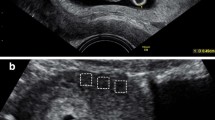Abstract
Objective
To determine the association between unexplained increased nuchal translucency (INT) and adverse pregnancy outcomes.
Patients and methods
The prospective database of our fetal down screening project was accessed to retrieve the records with NT measurement and complete follow-up. Pregnancies with pre-existing medical diseases, fetal chromosomal or structural abnormalities were excluded. The selected pregnancies were classified into the INT groups (> 95th percentile), the normal (< 95th percentile) group.
Results
Of 6026 available for analysis (INT:277; and normal: 5749), the abortion rate was significantly higher in the INT group, 18/277 (6.5%) versus 55/5749 (1.0%); p < 0.001. After excluding 73 cases ending-up with abortion, a total of 5953 women were analyzed for final pregnancy outcomes, including 260 (4.4%), and 5693 (95.6%) in the study group (INT), and the control group (normal NT), respectively. The rates of pre-eclampsia (7.3 vs. 4.1%; p: 0.018), preterm birth (12.7 vs. 8.4%; p: 0.023), fetal growth restriction (11.5 vs. 7.6%; p: 0.032), and low birth weight (16.5 vs. 10.0%; p: 0.002) were slightly, but significantly higher in the study group.
Conclusions
INT in the first trimester is associated with significantly increased risk of abortion, fetal growth restriction, preterm birth, low birth weight and pre-eclampsia.

Similar content being viewed by others
References
Shakoor S, Dileep D, Tirmizi S, Rashid S, Amin Y, Munim S (2016) Increased nuchal translucency and adverse pregnancy outcomes. J Matern Fetal Neonatal Med 30:1–4
Bilardo CM, Timmerman E, Pajkrt E, van Maarle M (2010) Increased nuchal translucency in euploid fetuses–what should we be telling the parents? Prenat Diagn 30:93–102
Pajkrt E, Mol BW, Bleker OP, Bilardo CM (1999) Pregnancy outcome and nuchal translucency measurements in fetuses with a normal karyotype. PrenatDiagn 19:1104–1108
Michailidis GD, Economides DL (2001) Nuchal translucency measurement and pregnancy outcome in karyotypically normal fetuses. Ultrasound Obstet Gynecol 17:102–105
Westin M, Saltvedt S, Almstrom H, Grunewald C, Valentin L (2007) By how much does increased nuchal translucency increase the risk of adverse pregnancy outcome in chromosomally normal fetuses? A study of 16,260 fetuses derived from an unselected pregnant population. Ultrasound Obstet Gynecol 29:150–158
Ayras O, Tikkanen M, Eronen M, Paavonen J, Stefanovic V (2013) Increased nuchal translucency and pregnancy outcome: a retrospective study of 1063 consecutive singleton pregnancies in a single referral institution. Prenat Diagn 33:856–862
Tahmasebpour A, Rafiee NB, Ghaffari S, Jamal A (2012) Increased nuchal translucency and pregnancy outcome. Iran J Public Health 41:92–97
Mula R, Gonce A, Bennasar M, Arigita M, Meler E, Nadal A et al (2012) Increased nuchal translucency and normal karyotype: perinatal and pediatric outcomes at 2 years of age. Ultrasound Obstet Gynecol 39:34–41
Piazze J, Anceschi MM, Cerekja A, La Torre R, Pala A, Papa A et al (2007) Nuchal translucency as a predictor of adverse pregnancy outcome. Int J Gynaecol Obstet 98:5–9
Sheizaf B, Sheiner E, Fink M, Hershkovitz R, Mazor M, Wiznitzer A (2009) A significant linear association exists between nuchal translucency thickness and adverse perinatal outcome in euploid fetuses. J Matern Fetal Neonatal Med 22:479–484
Hourrier S, Salomon LJ, Dreux S, Muller F (2010) Screening for adverse pregnancy outcome at early gestational age. Clin Chim Acta 411:1547–1552
The Fetal Medicine Foundation Center: Nuchal translucency measurement http://www.fetalmedicine.com/ultrasound-scans/nuchal-scan2016
Tongsong T, Simaraks S, Sirivatanapa P, Sudasna J, Wanapirak C, Kunavikatikul C et al (1993) Study of intrauterine growth from birthweight at Maharaj Nakhon Chiang Mai Hospital. J Med Assoc Thai 76:482–486
Haak MC, van Vugt JM (2003) Pathophysiology of increased nuchal translucency: a review of the literature. HumReprodUpdate 9:175–184
Ayras O, Eronen M, Tikkanen M, Rahkola-Soisalo P, Paavonen J, Stefanovic V (2016) Long-term outcome in apparently healthy children with increased nuchal translucency in the first trimester screening. Acta Obstet Gynecol Scand 95:541–546
Acknowledgements
We wish to thank the Faculty of Medicine Research Fund, Chiang Mai University, Thailand for financial support.
Funding
This study was funded by Faculty of Medicine, Chiang Mai Research Fund (Grant 50-2558).
Author information
Authors and Affiliations
Contributions
ST Conceptualization, Protocol development, Data collection, Manuscript drafting. SS Protocol development, Data collection. RS Protocol development, Data collection. TT Supervision, Conceptualization, Data analysis, Manuscript editing.
Corresponding author
Ethics declarations
Conflict of interest
All of the authors declare that they have no conflict of interest.
Ethical approval
This study was conducted with ethical approval of the institute review boards (Ethics Committee 4; Research ID 4548/Study Code: OBG-2560-04548).
Informed consent
Informed consent was obtained from all individual participants included in this study.
Rights and permissions
About this article
Cite this article
Tiyatha, S., Sirilert, S., Sekararithi, R. et al. Association between unexplained thickened nuchal translucency and adverse pregnancy outcomes. Arch Gynecol Obstet 298, 97–101 (2018). https://doi.org/10.1007/s00404-018-4790-9
Received:
Accepted:
Published:
Issue Date:
DOI: https://doi.org/10.1007/s00404-018-4790-9




